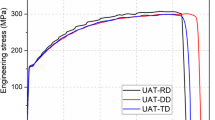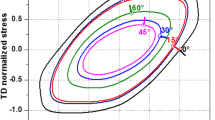Abstract
The predictive capability of a non-associated flow rule (non-AFR) for the strong plastic anisotropy was assessed. Based on Hill’s 48 function, a constitutive model under a non-AFR was established for aluminum alloy 6014-T4 sheet, in which the plastic potential function and the yield function were identified by Lankford coefficients (r-values) and yield stresses, respectively. Two constitutive models applying Hill’s 48 and Yld2000 functions under the AFR were also established for the comparison with the non-AFR Hill’s 48 model. These constitutive models were numerically carried out on Abaqus/Explicit by user subroutine (VUMAT). The representational ability of constitutive models was assessed in terms of the predictions on yield stresses and r-values. To further verify the simulated results, deep-drawing experiments of a cylindrical cup and a seat pan were performed. Simulation results were compared with the experiments from the aspects of the forming force, the earing profile, and the measured strain field using ex situ 3D DIC (Digital Image Correlation). Comparison results showed that non-AFR Hill’s 48 model gives the best overall prediction performance and requires less effort than the AFR Yld2000 model, indicating the effectiveness and superiority of non-AFR.











Similar content being viewed by others
References
Bridgman PW (1947) The effect of hydrostatic pressure on the fracture of brittle substances. J Appl Phys 18(2):246–258
Bridgman PW (1952) Studies in large plastic flow and fracture. McGraw-Hill, New York
Cvitanić V, Vlak F, Lozina Ž (2008) A finite element formulation based on non-associated plasticity for sheet metal forming. Int J Plast 24(4):646–687
Maeda Y, Yanagawa M, Barlat F (1998) Experimental analysis of aluminum yield surface for binary Al Mg alloy sheet samples. Int J Plast 14(4–5):301–318
Spitzig WA, Sober RJ, Richmond (1976) The effect of hydrostatic pressure on the deformation behavior of maraging and HY-80 steels and its implications for plasticity theory. Metall Trans A 7(11):1703–1710
Spitzig WA (1979) Effect of hydrostatic pressure on plastic-flow properties of iron single crystals. Acta Metall 27(4):523–534
Spitzig WA, Richmond O (1984) The effect of pressure on the flow stress of metals. Acta Metall 32(3):457–463
Bishop JFW, Hill R (1951) XLVI. A theory of the plastic distortion of a polycrystalline aggregate under combined stresses. London, Edinburgh, Dublin Philos Mag J Sci 42(327):414–427
Li M, Richmond O (1997) Intrinsic instability and nonuniformity of plastic deformation. Int J Plast 13(8–9):765–784
Stoughton TB (2002) A non-associated flow rule for sheet metal forming. Int J Plast 18(5–6):687–714
Hill R (1948) A theory of the yielding and plastic flow of anisotropic metals. Proc R Soc Lond A 193(1033):281–297
Barlat F, Lian K (1989) Plastic behavior and stretchability of sheet metals. Part I: a yield function for orthotropic sheets under plane stress conditions. Int J Plast 5(1):51–66
Barlat F, Lege DJ, Brem JC (1991) A six-component yield function for anisotropic materials. Int J Plast 7(7):693–712
Barlat F, Maeda Y, Chung K (1997) Yield function development for aluminum alloy sheets. J Mech Phys Solids 45:1727–1763
Barlat F, Brem JC, Yoon JW (2003) Plane stress yield function for aluminum alloy sheets—part 1: theory. Int J Plast 19(9):1297–1319
Barlat F, Aretz H, Yoon JW (2005) Linear transformation-based anisotropic yield functions. Int J Plast 21(5):1009–1039
Esmaeilpour R, Kim H, Park T, Pourboghrat F, Mohammed B (2017) Comparison of 3D yield functions for finite element simulation of single point incremental forming (SPIF) of aluminum 7075. Int J Mech Sci 133:544–554
Esmaeilpour R, Kim H, Park T, Pourboghrat F, Xu Z, Mohammed B, Abu-Farha F (2018) Calibration of Barlat Yld2004-18P yield function using CPFEM and 3D RVE for the simulation of single point incremental forming (SPIF) of 7075-O aluminum sheet. Int J Mech Sci 145:24–41
Stoughton TB, Yoon JW (2004) A pressure-sensitive yield criterion under a non-associated flow rule for sheet metal forming. Int J Plast 20(4–5):705–731
Taherizadeh A, Green DE, Ghaei A, Yoon JW (2010) A non-associated constitutive model with mixed iso-kinematic hardening for finite element simulation of sheet metal forming. Int J Plast 26(2):288–309
Park T, Chung K (2012) Non-associated flow rule with symmetric stiffness modulus for isotropic-kinematic hardening and its application for earing in circular cup deep-drawing. Int J Solids Struct 49(25):3582–3593
Safaei M, Zang S, Lee MG, De Waele W (2013) Evaluation of anisotropic constitutive models: mixed anisotropic hardening and non-associated flow rule approach. Int J Mech Sci 73:53–68
Safaei M, Yoon JW, De Waele W (2014) Study on the definition of equivalent plastic strain under non-associated flow rule for finite element formulation. Int J Plast 58:219–238
Manopulo N, List J, Gorji M (2015) A non-associated flow rule based yld2000-2d model//8th Forming Technology Forum Zurich
Wu B, Ito K, Mori N, Oya T, Taylor T, Yanagimoto J (2019) Constitutive equations based on non-associated flow rule for the analysis of forming of anisotropic sheet metals. Int J Precis Eng Manuf Green Technol 1-16
Paulino M, Yoon JW (2015) Study on yield function and plastic potential under non-associated flow for accurate earing prediction in cup drawing. Steel Res Int 86(8):852–860
Prates PA, Oliveira MC, Fernandes JV (2016) Identification of material parameters for thin sheets from single biaxial tensile test using a sequential inverse identification strategy. Int J Mater Form 9(4):547–571
Prates PA, Oliveira MC, Fernandes JV (2014) A new strategy for the simultaneous identification of constitutive laws parameters of metal sheets using a single test. Comput Mater Sci 85:102–120
Dunand M, Maertens AP, Luo M, Mohr D (2012) Experiments and modeling of anisotropic aluminum extrusions under multi-axial loading–part I: plasticity. Int J Plast 36:34–49
Logan RW, Hosford WF (1980) Upper-bound anisotropic yield locus calculations assuming< 111>-pencil glide. Int J Mech Sci 22(7):419–430
Qian LY, Fang G, Zeng P (2017) Modeling of the ductile fracture during the sheet forming of aluminum alloy considering non-associated constitutive characteristic. Int J Mech Sci 126:55–66
Aretz H (2004) Applications of a new plane stress yield function to orthotropic steel and aluminium sheet metals. Model Simul Mater Sci Eng 12(3):491–509
Chen Z, Fang G, Zhao JQ (2017) Formability evaluation of aluminum alloy 6061-T6 sheet at room and elevated temperatures. J Mater Eng Perform 26(9):4626–4637
“Standard test method for tensile strain-hardening exponents (n-values) of metallic sheet materials,” ASTM E646–07, ASTM International, 2007
Wang H, Wan M, Wu X, Yan Y (2009) The equivalent plastic strain-dependent Yld2000-2d yield function and the experimental verification. Comput Mater Sci 47(1):12–22
Deng Z, Hennig R (2017) Influence of material modeling on simulation accuracy of aluminum stampings. J Phys Conf Ser. IOP Publishing 896(1):012025
Chen Z, Fang G (2018) Determination of forming limit for aluminium alloy sheet eliminating the interferences of through-thickness stress and non-linear strain path. IOP Conference Series: Materials Science and Engineering. IOP Publishing 418(1):012051
Reu PL (2013) A study of the influence of calibration uncertainty on the global uncertainty for digital image correlation using a Monte Carlo approach. Exp Mech 53(9):1661–1680
Chen F, Chen X, Xie X, Feng X, Yang L (2013) Full-field 3D measurement using multi-camera digital image correlation system. Opt Lasers Eng 51(9):1044–1052
Tang Z, Liang J, Xiao Z, Guo C (2012) Large deformation measurement scheme for 3D digital image correlation method. Opt Lasers Eng 50(2):122–130
Pan B, Xie H, Yang L, Wang Z (2009) Accurate measurement of satellite antenna surface using 3D digital image correlation technique. Strain 45(2):194–200
Acknowledgments
Prof. Haibo Wang of the North China University of Technology helped conduct equal biaxial tension tests. The author would like to express our thanks to these supports and helps.
Funding
The present study is financially supported by National Natural Science Foundation of China (No. 51705279 and No. 51375256).
Author information
Authors and Affiliations
Corresponding author
Ethics declarations
Conflict of interest
The authors declare that they have no conflict of interest.
Additional information
Publisher’s note
Springer Nature remains neutral with regard to jurisdictional claims in published maps and institutional affiliations.
Rights and permissions
About this article
Cite this article
Chen, Z., Zhao, J. & Fang, G. Finite element modeling for deep-drawing of aluminum alloy sheet 6014-T4 using anisotropic yield and non-AFR models. Int J Adv Manuf Technol 104, 535–549 (2019). https://doi.org/10.1007/s00170-019-03921-w
Received:
Accepted:
Published:
Issue Date:
DOI: https://doi.org/10.1007/s00170-019-03921-w




